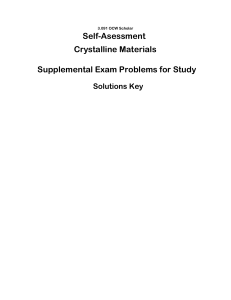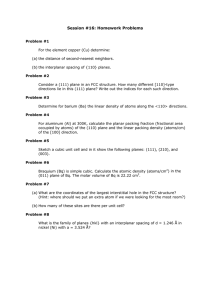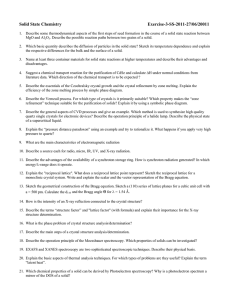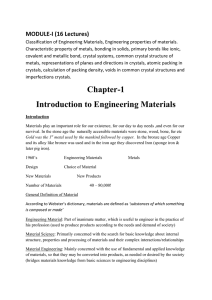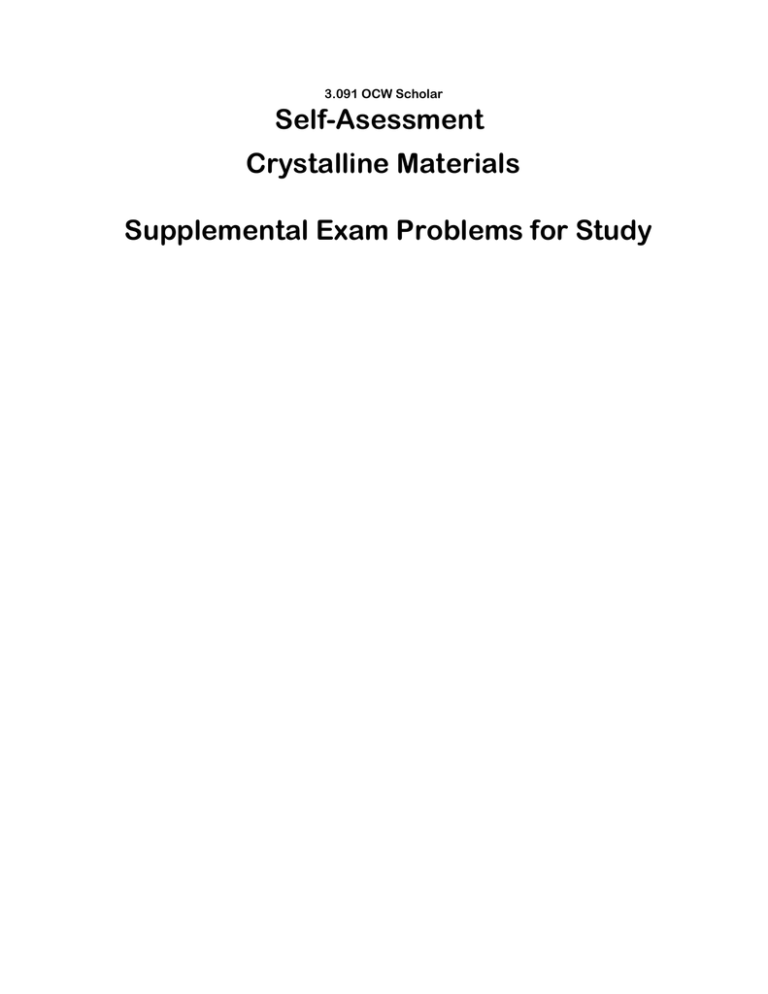
3.091 OCW Scholar
Self-Asessment
Crystalline Materials
Supplemental Exam Problems for Study
3.091 Fall Term 2007 Test #2
page 2
Problem #1
z
z
y
y
x
x
(a) Using proper crystallographic notation identify the direction (left) and the plane (right) depicted in
the above sketches.
(b) Here is the (011) plane in a unit cell of lithium (Li). Indicate the positions of all atoms lying in the
plane. Represent atoms as 2-dimensional slices of space-filling spheres.
3.091 Fall Term 2007 Test #2
page 3
Problem #2
(a) A crystal of iridium (Ir) is analyzed by x-ray diffraction through exposure to molybdenum Kα
radiation, for which λKα = 0.721 Å = 7.21 × 10−11 m. Calculate the angle of reflection, θ, of the
lowest-index plane present in the diffractogram. The lattice constant of Ir, a, is 3.84 Å.
(b) If you wanted to increase the angle at which the reflection described in part (a) is observed, would
you replace the Mo target with a silver (Ag) target or a copper (Cu) target? Explain the reasoning
behind your choice.
(c) In one drawing, sketch the emission spectra (intensity versus wavelength) of an x-ray tube operated
at each of two different values of plate voltage, V1 and V2, where V2 > V1 > the threshold voltage to
generate the characteristic lines. On each spectrum in your sketch, label the features associated with
Kα radiation, Lα radiation, λshortest wavelength, and Bremsstrahlung.
Problem #1
z
z
y
y
x
[111]
x
(220)
(a) For each unit cell above, draw the crystallographic feature indicated and label it clearly.
(b) Urbium (Ub) is an upscale element found in large cities. Its unit cell is cubic. Using the values of its
molar volume and lattice constant, determine the crystal structure of Ub.
DATA: molar volume, Vmol = 9.41 cm3/mol
lattice constant, a = 3.15 Å = 3.15 10–8 cm
(c) Calculate the linear density of atoms along [011] in lithium (Li). The value of the lattice constant in
Li is 3.51 Å. Express your answer in units of atoms /Å.
3.091 Fall Term 2008 Test #2
page 2
Problem #2
(a) Draw the energy-level diagram of the
target (anode) of an x-ray tube
operating at a plate voltage great
enough to generate the characteristic
lines. Indicate the features associated
with emission of K, K, L,
and L radiation. The drawing need
not be to scale but should reflect
qualitative distinctions in magnitudes
of transition energies.
(b) Estimate the energy of the transition associated with the generation of K radiation from a target
made of silver (Ag). The values of the screening factor, , are 1 for K and 7.4 for L.
(c) A sample of chromium (Cr) is analyzed by x-ray diffraction using copper K radiation for which
K = 1.5418 Å. Determine the Miller indices of the plane from which the angle of reflection, , is
31.4º. The lattice constant of Cr, a, is 2.96 Å. Report your answer in the form (hkl).
3.091 Fall Term 2008 Test #3 page 2
Problem #1
The dominant defect in zirconia (ZrO2) is the Schottky disorder.
(a) Write the reaction that represents the formation of a Schottky defect in ZrO2.
(b) Calculate the fraction of vacant zirconium sites in a crystal of ZrO2 at a temperature of 333 K. The
enthalpy of Schottky defect formation, HS, has a value of 2.1 eV / defect, and the entropic
prefactor, A, has a value of 3.091.
(c) To increase the population of oxide vacancies ZrO2 can be doped with calcia (CaO). Write the
reaction showing that for each CaO that is incorporated into the ZrO2 crystal an oxide vacancy is
formed.
(d) The figure below is an image of the ATOMIX™ kinetic sculpture that was shown in lecture. The
device consists of a layer of stainless steel ball bearings free to roll about between two plates of
poly(methyl methacrylate) (PMMA). The balls can be thought of as atoms in a two-dimensional
likeness of a solid composed of atoms bearing no net charge, e.g., a metal. For each of the following,
mark directly on the image one feature that would serve as a two-dimensional representation:
(1) vacancy;
(2) grain boundary;
(3) free surface;
(4) amorphous region.
3.091 Fall Term 2008 Final Exam
page 3
Problem #2
The crystal structure of cesium chloride (CsCl) is shown
in the adjacent figure. The dark spheres represent atoms of Cl.
(a) Name the crystal system.
(b) Name the Bravais lattice.
(c) Name the basis of the crystal structure and indicate the basis by markup of the figure.
Problem #3
(a) Sketch a fragment of the (011) plane in tungsten (W) to show the arrangement of atoms, which are to
be represented as hard spheres.
(b) On the sketch you have drawn in answer to part (a), draw and label all directions along which slip
occurs and name the family of directions to which they belong.
(c) Calculate the atomic packing density in the (011) plane of W. Express your answer in units of
atoms cm–2.
3.091 Fall Term 2008 Final Exam
page 10
Problem #9
(a) Draw a cartoon depicting the device that generates x-rays. Label the following features: vacuum tube,
cathode, anode, target. Indicate on your drawing the emanation of x-rays.
(b) Röntgen’s gas discharge tube was highly inefficient and unsafe. Among the modifications made by
William D. Coolidge (MIT class of 1896), were the following: vacuum tube instead of tube
containing gas; and water cooled anode. Describe how each modification represents an
improvement over Röntgen’s device. In your answer specify the problem addressed by the
modification and explain how the modification overcomes the problem.
(c) The Duane-Hunt Law calculation gives a value of 0.666 Å (6.66 1011 m) for the shortest
wavelength produced by an x-ray tube. What must be the value of the plate voltage under these
circumstances?
3.091 Fall Term 2008 Final Exam
page 11
Problem #10
Give the rotational symmetry of each of the following patterns. Express your answer as n-fold.
All M.C. Escher works © 2010 The M.C.
Escher Company – The Netherlands. All rights reserved.
MIT OpenCourseWare
http://ocw.mit.edu
3.091SC Introduction to Solid State Chemistry
Fall 2009
For information about citing these materials or our Terms of Use, visit: http://ocw.mit.edu/terms.

